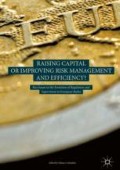Abstract
This chapter aims at describing the evolution of the capital adequacy framework for banks at international scale. As known, the main reasons for the introduction of Basel III link back to the crisis and the inability of banks to adequately deal with its consequences, mainly due to operational distortions that have gradually characterised the banking business in the last decades. In order to give response to the crisis, the current framework focuses on the provision of higher-quantity and better-quality own funds, the introduction of countercyclical buffers, the discipline of rules for managing liquidity risk and the containment of leverage.
Access this chapter
Tax calculation will be finalised at checkout
Purchases are for personal use only
References
Allen & Overy. (2014, January). Capital requirements directive IV framework. Internal Ratings Based Approach to Credit Risk in the Banking Book.
Amorello, L. (2016). Beyond the horizon of banking regulation: What to expect from Basel IV. Harvard International Law Journal, 58, 18.
BCBS—Basel Committee on Banking and Supervision. (1988, July). International convergence of capital measurement and capital standards.
BCBS—Basel Committee on Banking and Supervision. (2005, November). Amendment to the capital accord to incorporate market risks.
BCBS—Basel Committee on Banking and Supervision. (2006, June). Basel II: International convergence of capital measurement and capital standards: A revised framework. Comprehensive version.
BCBS—Basel Committee on Banking and Supervision. (2009, July). Guidelines for computing capital for incremental risk in the trading book.
BCBS—Basel Committee on Banking and Supervision. (2011, June). Basel III: A global regulatory framework for more resilient banks and banking systems. Revised version.
BCBS—Basel Committee on Banking and Supervision. (2013a, January). Basel III: The liquidity coverage ratio and liquidity risk monitoring tools.
BCBS—Basel Committee on Banking and Supervision. (2013b, July). The regulatory framework: Balancing risk sensitivity, simplicity and comparability.
BCBS—Basel Committee on Banking and Supervision. (2014a, April). Supervisory framework for measuring and controlling large exposures—Final standard.
BCBS—Basel Committee on Banking and Supervision. (2014b, October). Basel III: The net stable funding ratio.
BCBS—Basel Committee on Banking and Supervision. (2014c, November). Reducing excessive variability in banks’ regulatory capital ratios.
BCBS—Basel Committee on Banking and Supervision. (2015, December). Revisions to the standardised approach for credit risk—Second consultative document.
BCBS—Basel Committee on Banking and Supervision. (2016a, January). Minimum capital requirements for market risk.
BCBS—Basel Committee on Banking and Supervision. (2016b, March). Reducing variation in credit risk-weighted assets—Constraints on the use of internal model approaches—Consultative document.
BCBS—Basel Committee on Banking and Supervision. (2016c, March). Standardised measurement approach for operational risk—Consultative document.
BCBS—Basel Committee on Banking and Supervision. (2016d, April). Interest rate in the banking book.
BCBS—Basel Committee on Banking and Supervision. (2017, January). Pillar 3 disclosure requirements—Consolidated and enhanced framework.
Birindelli, G., & Ferretti, P. (2017). Operational risk management in banks. Regulatory, organizational and strategic issues. London: Palgrave Macmillan.
Capgemini. (2015). Basel IV, changing the regulatory landscape of banks.
Colombini, F. (2013). Interview. In I. Pezzuto (Ed.), “Predictable and avoidable. Repairing economic dislocation and preventing the recurrence of crisis”, experts’ insights for improved governance. Farnham: Gower.
Crouhy, M., Galai, D., & Mark, R. (2006). The essentials of risk management. New York: McGraw-Hill.
Decamps, J.-P., Rochet, J.-C., & Roger, B. (2004). The three pillars of Basel II: Optimizing the mix. Journal of Financial Intermediation, 13(2), 132–155.
Demirguc-Kunt, A., Detragiache, E., & Merrouche, O. (2010). Bank capital: Lessons from the financial crisis. Policy Research Working Paper Series 5473. The World Bank.
Garside, T., & Bech, J. (2003). Dealing with Basel II: The impact of the New Basel Capital Accord. Balance Sheet, 11(4), 26–31.
Haldane A. G., & Madouros, V. (2012, August 31). The dog and the Frisbee, Speech at the Federal Reserve Bank of Kansas City’s 366th economic policy symposium. The changing policy landscape, Jackson Hole, Wyoming.
Kato, R., Kobayashi, S., & Saita, Y. (2010, May). Calibrating the level of capital: The way we see it. Bank of Japan Working Paper, 10-E-6.
KPMG. (2016, December). The world awaits: Basel IV nears completion.
Lastra, R. M. (2004). Risk-based capital requirements and their impact upon the banking industry: Basel II and CAD III. Journal of Financial Regulation and Compliance, 12(3), 225–239.
Ledo, M. (2011). Towards more consistent, albeit diverse, risk-weighted assets across banks. Estabilidad Financiera, 21(11), 41–61.
McKinsey & Company. (2017, April). Basel IV: What’s next for banks?
Pezzuto, I. (2013). Predictable and avoidable. Repairing economic dislocation and preventing the recurrence of crisis. Farnham: Gower.
Tutino, F. (2011). Raccolta, liquidità, patrimonio in Basilea III: impatti su strategie e gestione delle banche. In F. Tutino, G. Birindelli, & P. Ferretti (Eds.), Basilea III. Gli impatti sulle banche (pp. 361–394). Milano: Egea.
Tutino, F. (2016). Fiducia nelle banche, bail-in, tutela del risparmio: un approccio sistemico di lungo periodo. Rivista Bancaria, 4–5, 191–200.
Van Roy, P. (2005, August). Credit ratings and the standardised approach to credit risk in Basel II. ECB Working Paper, Number 517.
Author information
Authors and Affiliations
Editor information
Editors and Affiliations
Rights and permissions
Copyright information
© 2018 The Author(s)
About this chapter
Cite this chapter
Ferretti, P. (2018). Capital Constraints by Regulation in Europe. In: Colombini, F. (eds) Raising Capital or Improving Risk Management and Efficiency?. Palgrave Macmillan, Cham. https://doi.org/10.1007/978-3-319-71749-4_5
Download citation
DOI: https://doi.org/10.1007/978-3-319-71749-4_5
Published:
Publisher Name: Palgrave Macmillan, Cham
Print ISBN: 978-3-319-71748-7
Online ISBN: 978-3-319-71749-4
eBook Packages: Economics and FinanceEconomics and Finance (R0)

